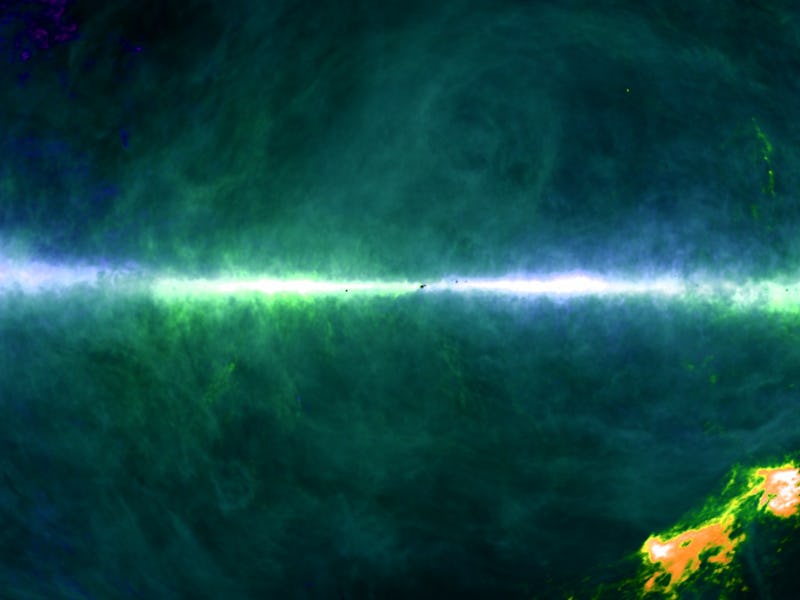This New Map of the Milky Way Is a "Cosmic Time Capsule"

By harnessing the power and ubiquity of the hydrogen atom, astrophysicists just brought us a detailed map of the Milky Way — all of it. Using German and Australian telescopes, the survey known as HI4PI, tracked hydrogen across the galaxy, uniting more than one million discrete observations, to form a single cohesive map.
In a paper accompanying the image, to be published Thursday in the journal Astronomy & Astrophysics, we learn that the HI4PI survey measured radio wavelength radiation emitted from hydrogen atoms, incorporating data gathered over the course of 11 years.
It’s a combination of the Effelsberg-Bonn HI Survey (EBHIS) and the Parkes Galactic All-Sky Survey (GASS) — each of which represent more than 1,000 hours of observing time.
Stars form from interstellar matter, the most abundant ingredient, for which is hydrogen.
The image colors reflect gas at differing velocities. The plane of the Milky Way runs horizontally across the middle of the image. The Magellanic Clouds can be seen at the lower right.
Dr. Benjamin Winkel of the Max Planck Institute for Radio Astronomy tells Inverse that the project’s aim was to replace the last all-sky data set, which is from 2005, as the “prime resource” for Milky Way imaging.
The detail with which he and his colleagues mapped hydrogen atoms, means that, due to those atoms’ abundance in space, we now have a portrait of even the furthest outskirts of the galaxy — regions that other recently released maps have struggled to represent fully. Held up against other recent hydrogen maps of the galaxy — namely, the Leiden/Argentine/Bonn (LAB) survey — it represents a marked improvement. In LAB’s case, by a factor of two for sensitivity, and a factor of four for angular resolution.
The image intensity reflects the total hydrogen content. The plane of the Milky Way runs horizontally across the middle of the image.
It also means that we can now see the details in the structures between stars, like mass concentrations within molecular clouds, that could eventually evolve into stars. Dr. Juergen Kerp, the EBHIS principal investigator (as well as Winkel’s former thesis advisor), has already detected a giant hydrogen lobe around neighboring galaxy Andromeda.
There have been many previous attempts to survey the entire galaxy. One of the longest-standing obstacles has been interference in the kind of radio wavelengths HI4PI measures; human-made ‘noise’ from cell phones and broadcast stations. The researchers had to develop countless individual algorithms to clear up the data points, one by one, and their attention to detail in that regard is a big part of why HI4PI is as successful as it is.
“The HI4PI map is the sharpest view of the HI distribution of the Milky Way galaxy ever made,” Juergen tells Inverse.
It’s “cosmic time capsule,” a snapshot of literally everything.
So what’s next for the galaxy cartographers? There are more questions to be answered.
“How does the Milky Way get the new gas it requires to continue forming stars? And where are all of the small dwarf galaxies that must surround our Milky Way? The next steps will be exciting, Naomi McClure-Griffiths, a professor at the Australian National University, says.